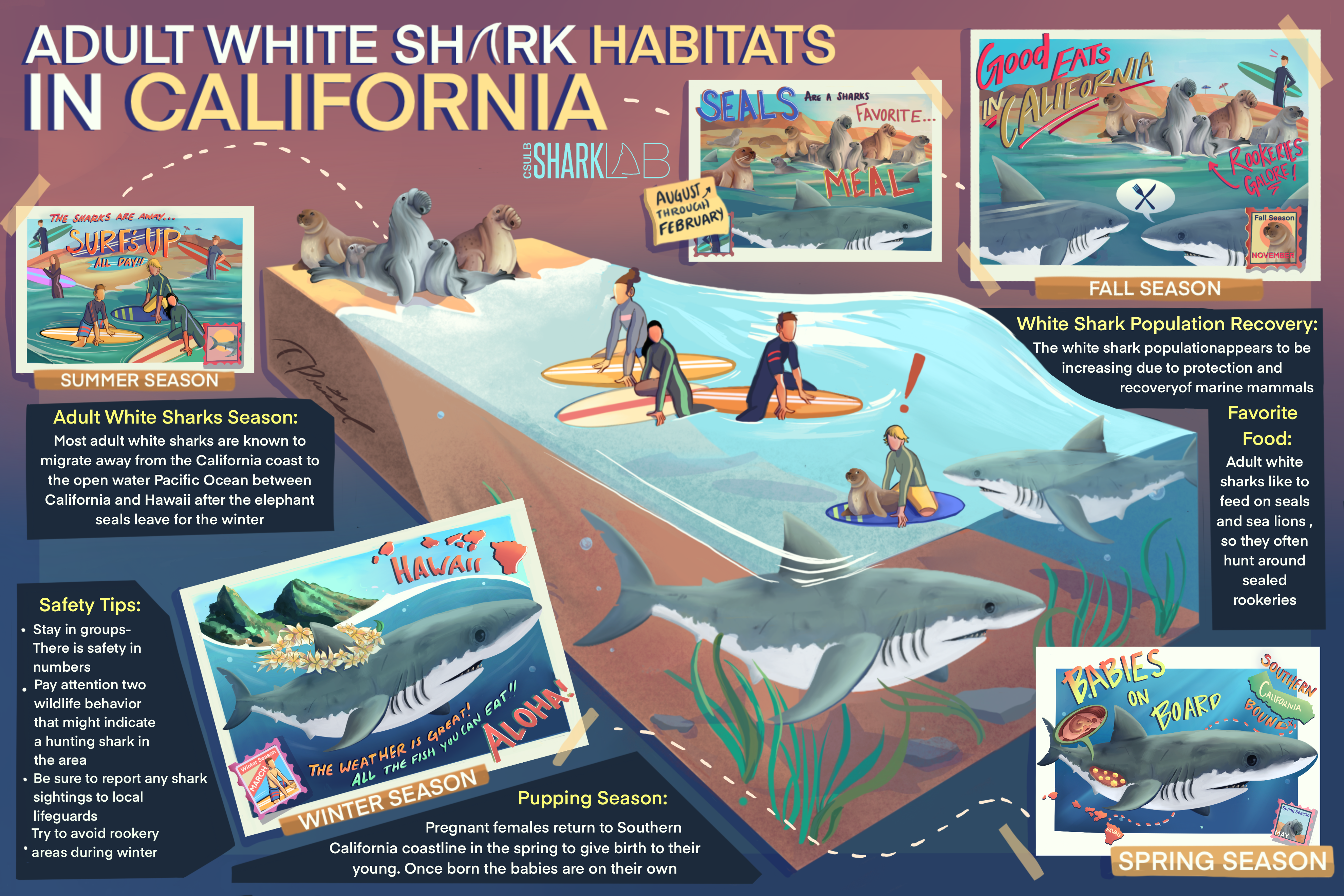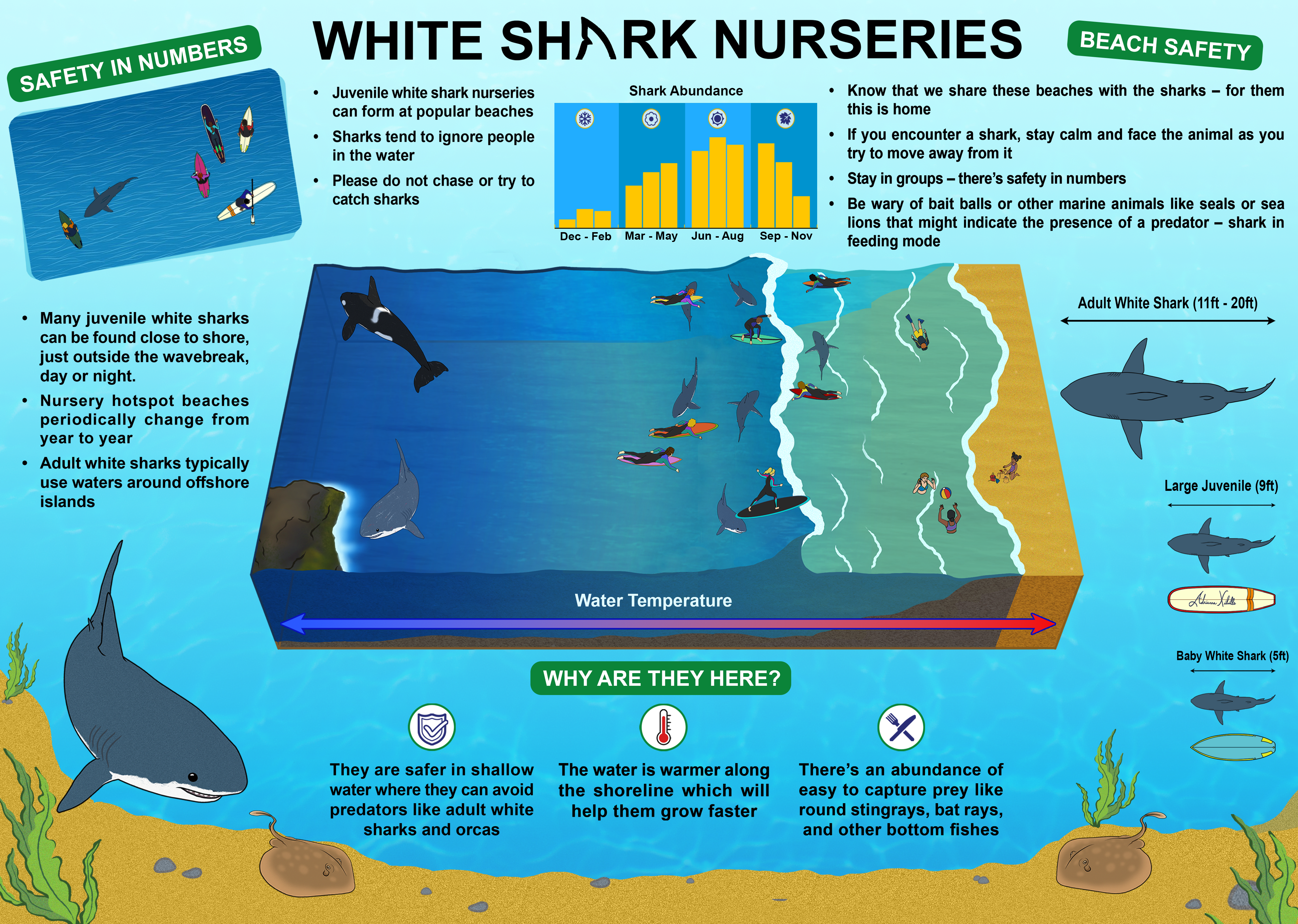CA Shark Beach Safety Program
The State of California Shark Beach Safety Program at CSULB received funding in June 2018 with the purpose of engaging in scientific research on the growing white shark population off the coast of California to increase knowledge, improve public understanding and reduce public safety risks. Funding ($3.75 mil for 5 years) was directed to the CSULB Shark Lab, one of the oldest and most recognized shark research facilities in the US.
The Shark Beach Safety Program consists of three major approaches including:
- Scientific research - to advance our knowledge of white shark biology, behavior, and ecology off the California coast.
- Education - to provide a science-based curriculum about sharks to water safety personnel, fishers, and K-12 students.
- Public outreach - to provide science-based information about white sharks and beach safety to the general public (residents and visitors).
The ultimate goal of this program is to understand and reduce human risk of shark bites and the economic challenges that surround these incidents, to preserve the need for State and Federal protection for white sharks due to their ecological importance and provide those who use California beaches with science-based information to enhance their safety.
Specific research projects are currently underway to answer critical questions regarding why juvenile white sharks aggregate at certain beaches, how long they remain at these locations, what they are doing at these locations, and how often do people encounter sharks while recreating at these beaches. The ultimate goal of these specific research projects is to allow for our ability to:
- quantify encounter rates and make realistic risk assessments.
- predict when sharks might select certain beaches.
- provide lifeguards and the public with methods to reduce risk of injury from sharks.
Shark and Water Users Survey
Assessing the overlap of human water users and sharks in the ocean
We observed that juvenile white shark aggregation sites had a 97% rate of co-occurrence between humans and sharks throughout the course of the study, showing that aggregation sites are also hot spots for human-shark encounters.
Read the journal article: Patterns of Overlapping Habitat Use of Juvenile White Shark and Human Recreational Water Users Along Southern California Beaches
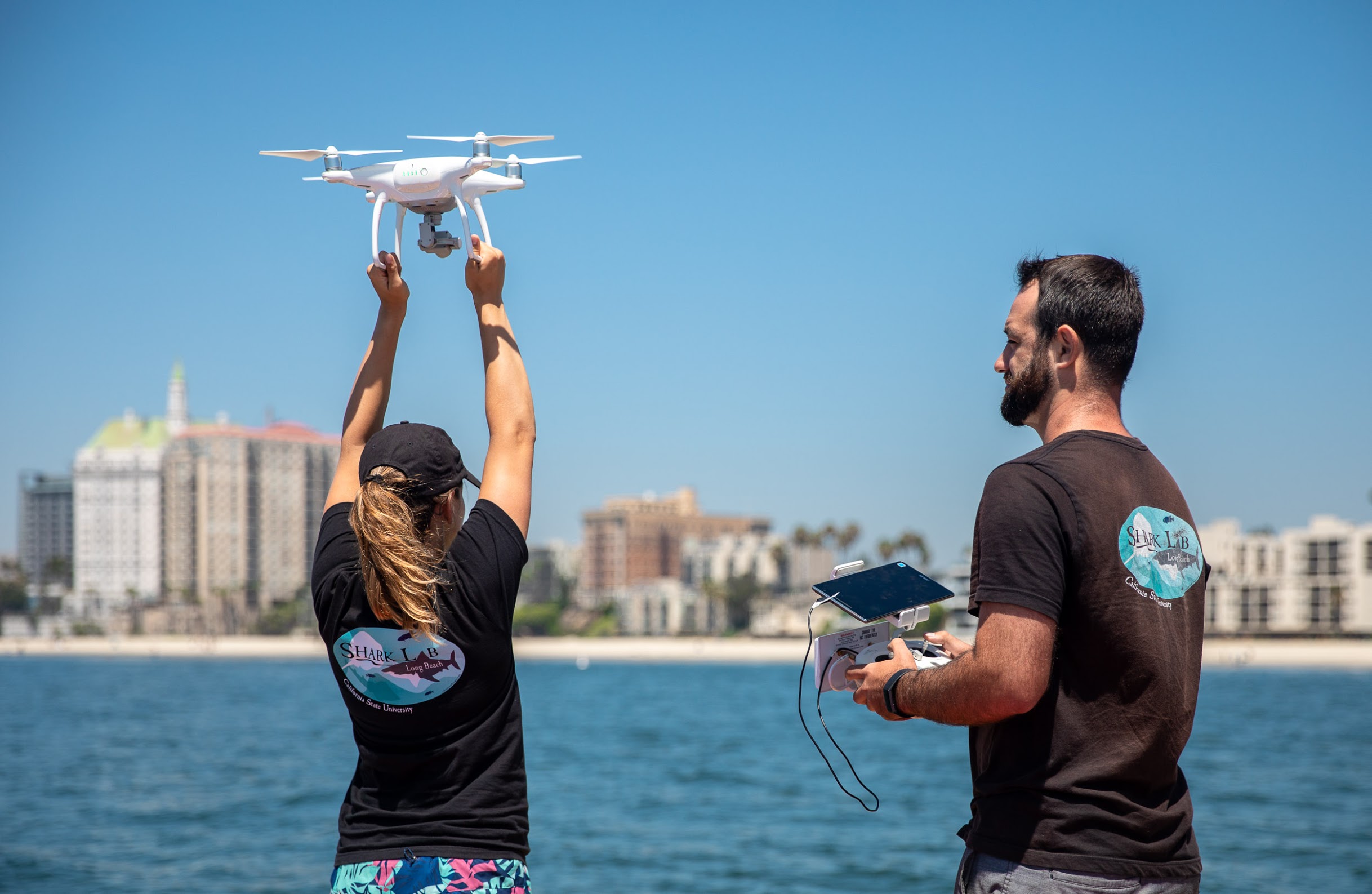
White Shark Tagging and Tracking
To determine how and when white sharks may use southern California beaches, we have been conducting an electronic tagging study over the last 13 years.
These findings have been very useful in understanding white shark migration behavior which is relevant to shark-human encounter probabilities as the population grows.
Published studies:
- A Biologging Database of Juvenile White Sharks from the Northeast Pacific
- Interannual Nearshore Habitat Use of Young of the Year White Sharks of Southern California
- Non-random Co-occurence of Juvenile White Sharks at Seasonal Aggregation Sites in Southern California
- High Resolution Acoustic Telemetry Reveals Swim Speeds and Inferred Field Metabolic Rates in Juvenile White Sharks
- Evidence of Increasing Juvenile White Sharks Habitat Use at Northern Channel Islands
- Quantifying Thermal Cues that Initiate Mass Emigrations in Juvenile White Sharks
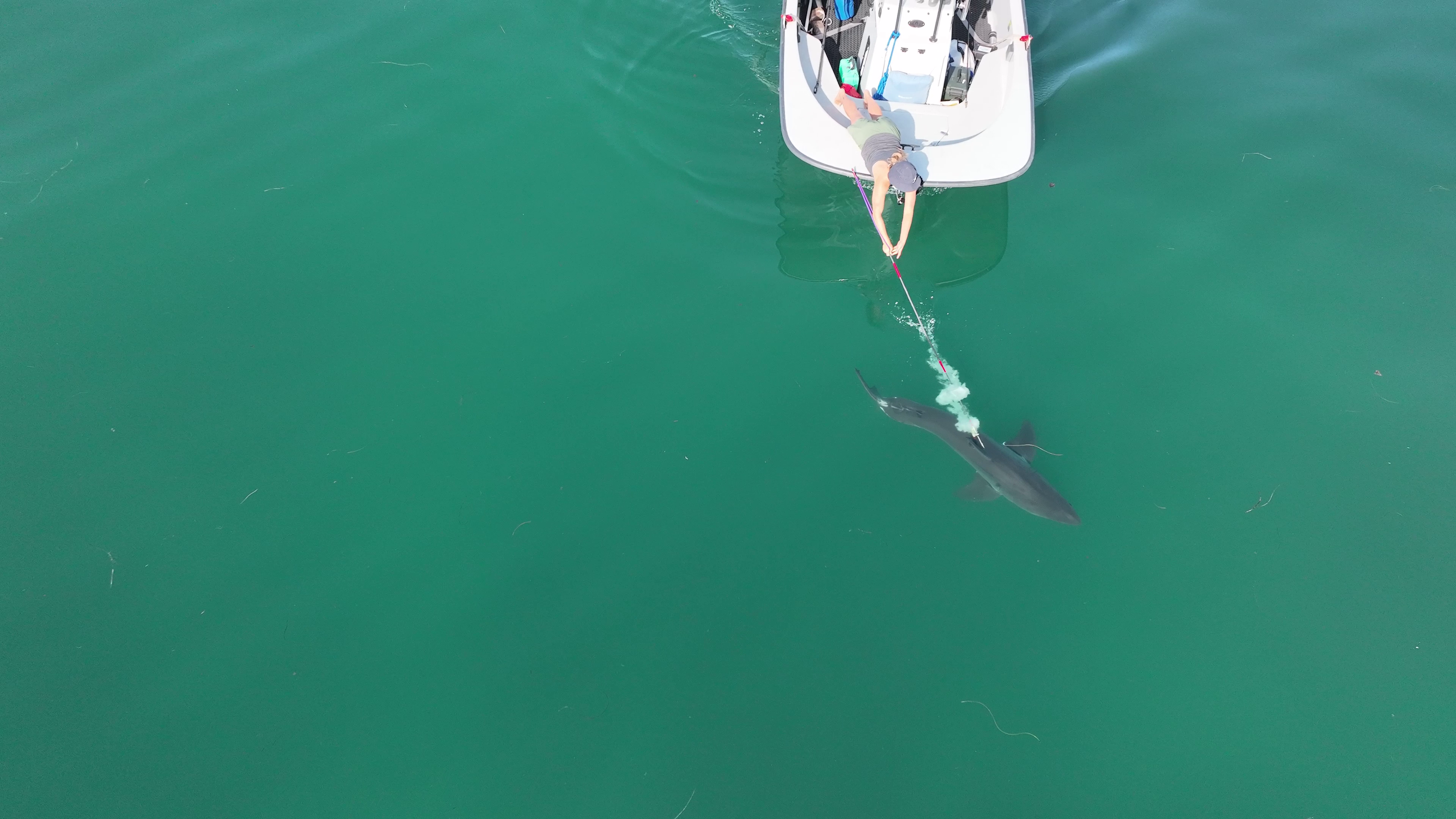
AUV Beach Surveys
With the acquisition of the autonomous underwater robot and associated environmental sensors we were able to conduct 3D surveys of three southern California beaches this year. Environmental parameters measured at each site included depth, temperature, conductivity, salinity, turbidity (water clarity), dissolved oxygen, chlorophyll, and blue-green algae concentrations.
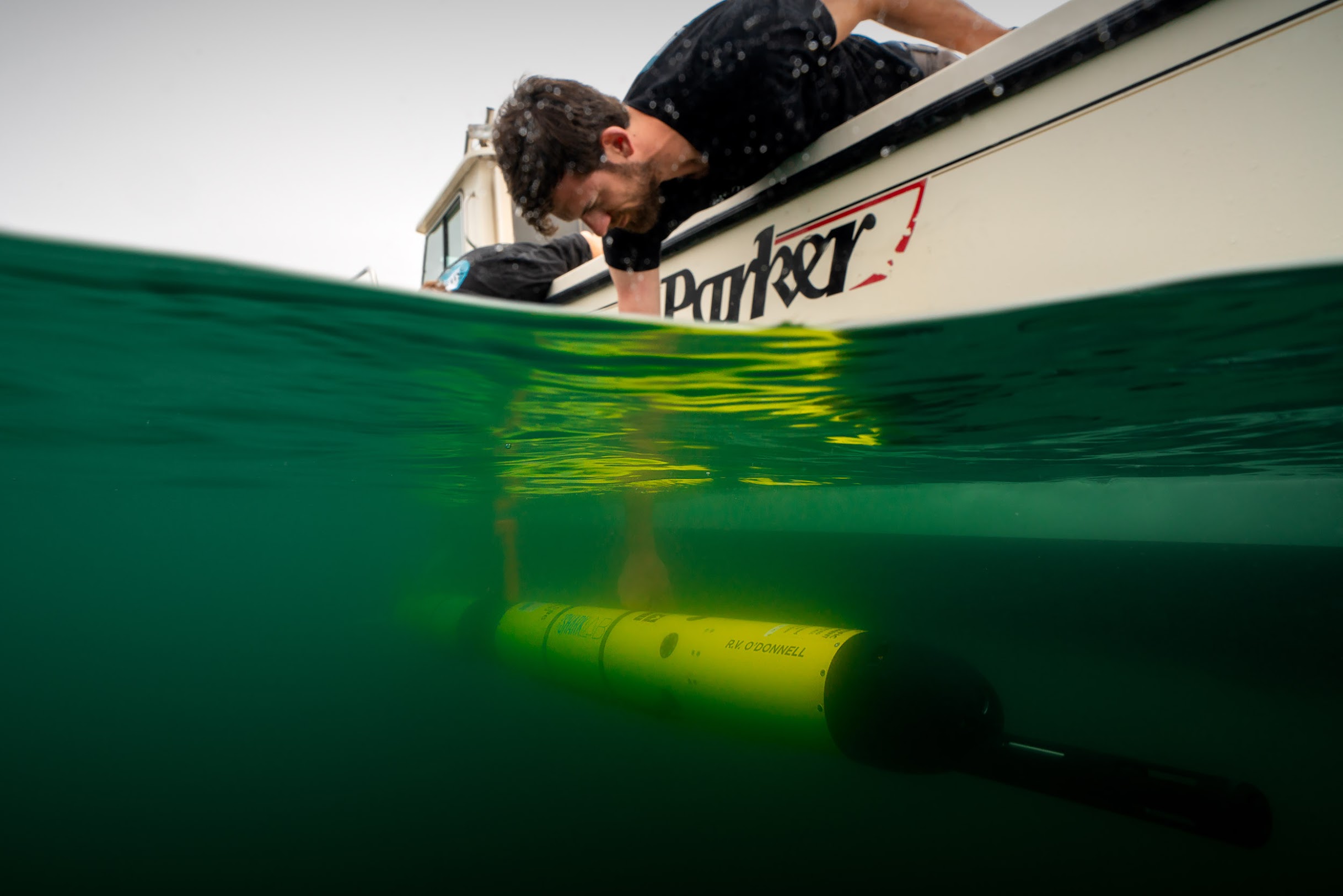
Juvenile White Shark Prey Abundance
We assess prey community abundance and composition at aggregation and non-aggregation sites using beach seines, baited remote underwater videos (BRUVs), and environmental DNA (eDNA). Additionally, we are calibrating eDNA sampling methodology to determine if water sampling for white shark abundance is a viable tool. We also assessed diet through stable isotopes.
Sound Characterizations of Beach Goers
How juvenile white sharks detect and respond to people in the water is unknown.To determine whether sound has an influence on juvenile white shark behavior we recorded sounds from beach goers and then characterized them in terms of what is detectable to sharks. We used a 4-channel hydrophone to measure sound pressure and particle acceleration in order to calculate the particle motion components of sounds from swimmers, kayakers, and surfers.
Shark Perception and Beach Safety Study
The Shark Lab has teamed up with Drs. Gabriella Hancock (CSULB Associate Professor of Psychology) and Katie Dudley (CSULB Assistant Professor of Recreation & Leisure Studies) to examine the sociological impacts and public perceptions of sharks and other marine wildlife in relation to beach safety.
Read the journal article: An Etiological Examination of Behavioral Intentions to Support Shark and Stingray Conservancy: The Effects of Beliefs in Elasmobranchs' Cognitive and Affective Capacities
Economic Impact of Shark Interactions
Drs. Katie Dudley and Dede Long are using a difference-in-differences approach with staggered treatment to investigate the economic consequences of shark bites. The project entails acquiring disaggregated data on tourism outcomes (e.g., hotel occupancy), rather than relying on aggregated state-level data, which is, at present, the primary data available across all states.
Data Science and Sharing
Our staff data analyst has explored a large amount of our available data and has provided some insights and motivations to further research. We believe that the ethical sharing of data can only progress scientific discovery. As such, we have shared data with multiple interdepartmental, state-wide, national, and international organizations and laboratories. This open data-sharing ideology allows for cross-discipline collaboration.
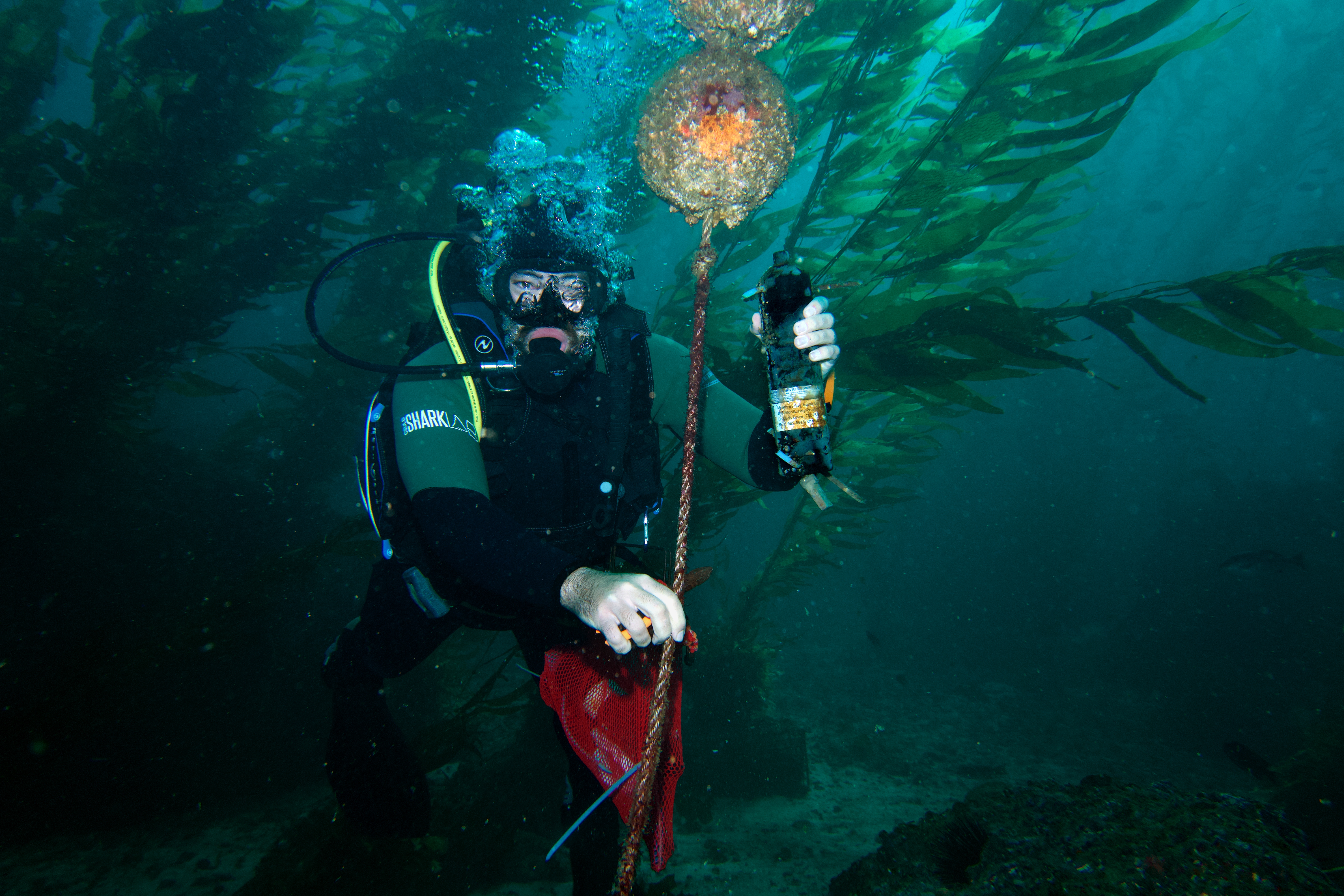
The education department is the second component of the Shark Beach Safety Program, serving as a vital link that conveys our research discoveries and unique curriculum to diverse audiences of varying ages and backgrounds. Its role is to provide information more easily understandable and accessible to the public within Southern California.
Thanks to the improved circumstances surrounding the global COVID-19 pandemic, we had the opportunity to enhance our educational initiatives and host programs and events that were previously beyond our reach.
Lifeguard Training Program
In 2019 we designed a training program for lifeguards providing instruction on how to:
- identify typical large marine life found off California beaches
- reduce human interaction and injury
- interpret shark behavior.
This curriculum focuses on interpretation of the CA Shark Sightings and Incidents policy developed by ocean lifeguard Chiefs across the State.
Junior Lifeguard Training Program
Approximately 20,000 Junior lifeguards are found within the coastal communities of Southern California, intended for kids ages 8-17. Our collaboration with several of these agencies and municipalities has enabled us to offer a condensed version of marine life identification training specifically tailored for Junior lifeguards.
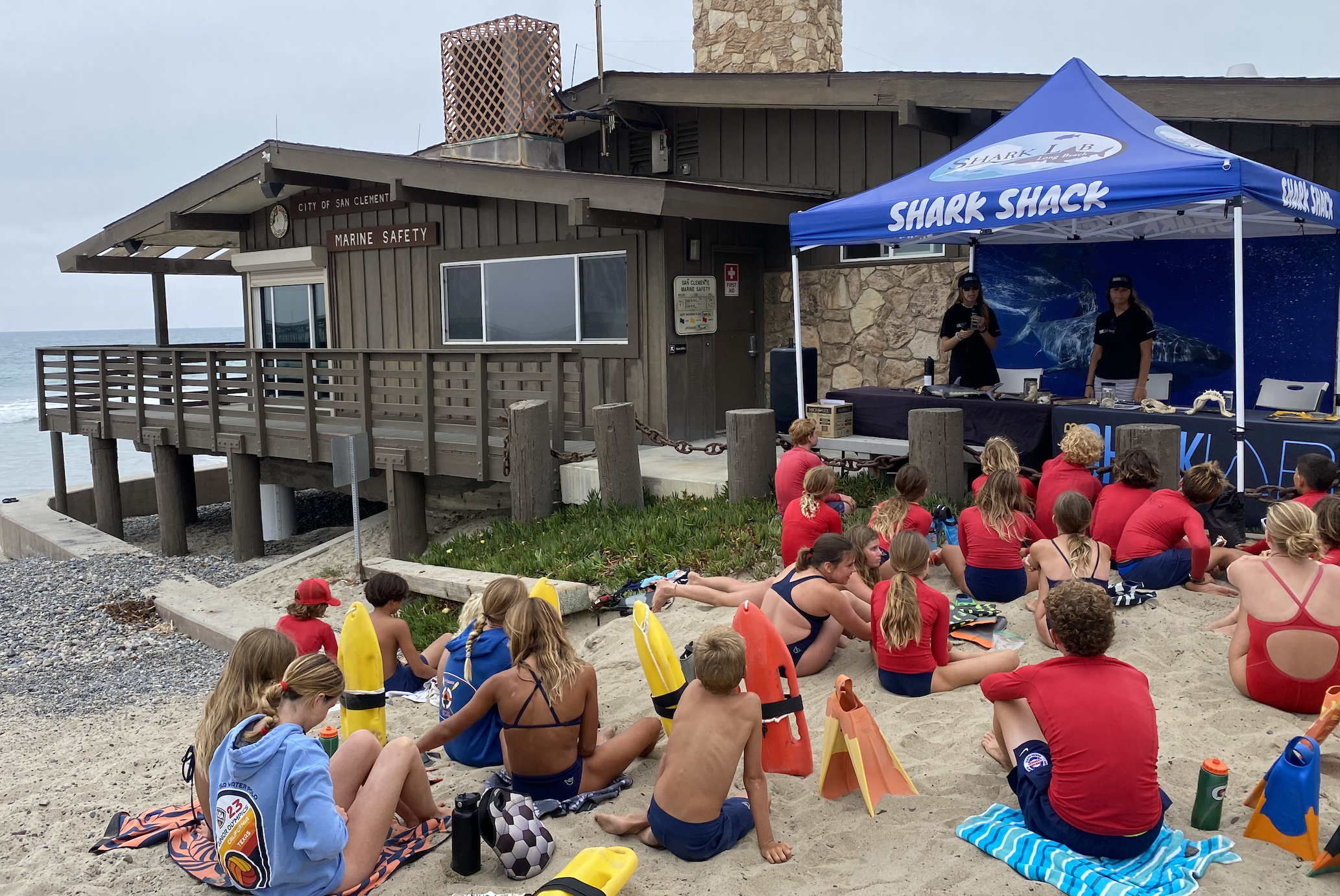
K-12 Education Program
The aim of these initiatives is to engage students from a wide range of backgrounds and ignite their interest in STEM fields, encompassing science, technology, engineering, and mathematics.
Throughout the recent school year, the Shark Lab conducted virtual programming dedicated to reaching K-12 classrooms.
Four different in-person presentations were developed to conduct 45-minute lessons with teachers and their students in their classrooms.
Learn more about our education programs.
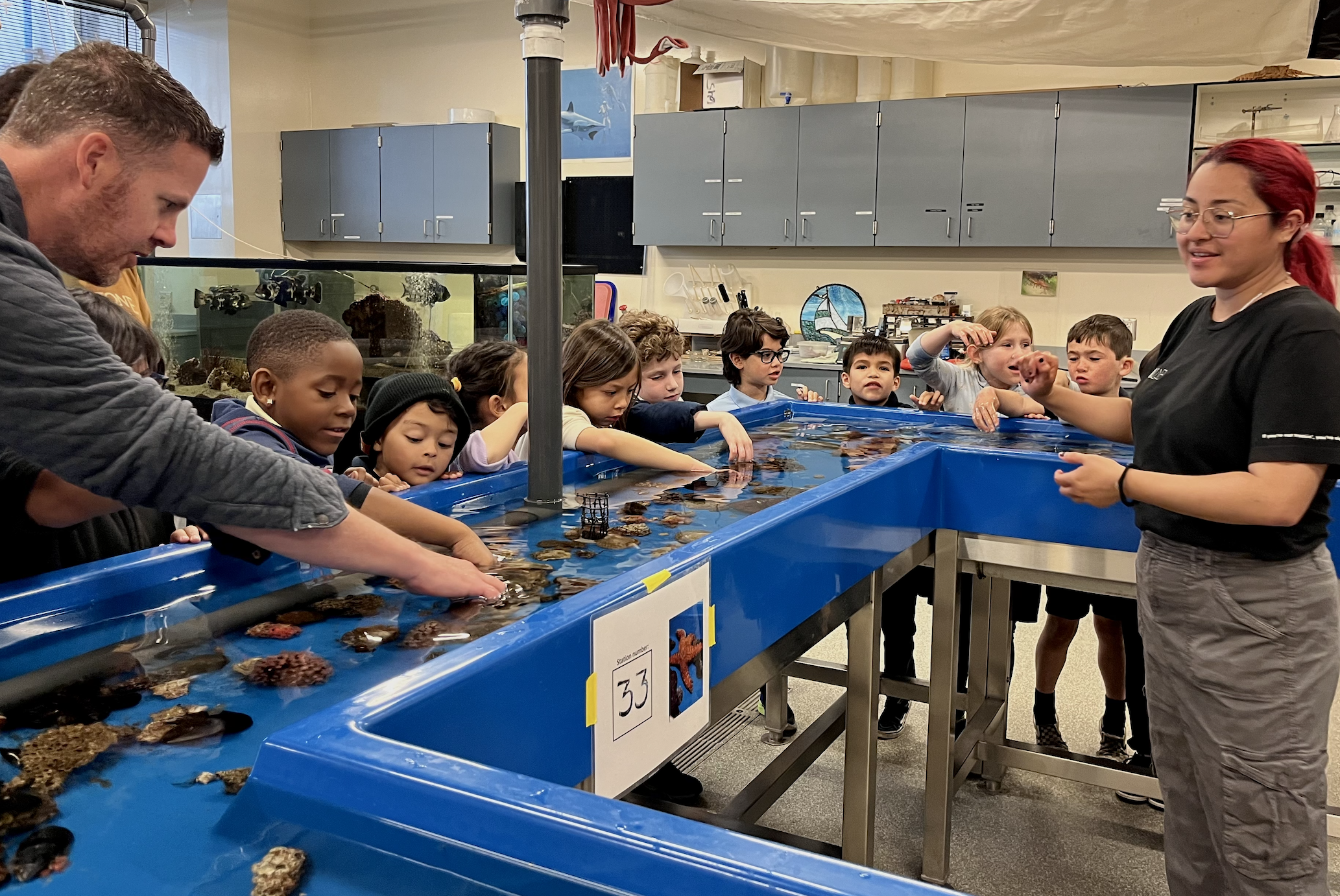
K-12 Volunteer Educators
The other goal of the K-12 education programs was to train diverse CSULB undergraduates studying marine biology, physics, math, engineering, and computer science to deliver the new curriculum to live classrooms. The volunteer educators have gained formal teaching experience working side-by-side with scientists and other educators.
The CSULB Shark Lab has maintained its robust outreach program, offering California-based marine education organizations, lifeguard agencies, and other institutions beach safety education with up-to-date scientific insights.
Shark Shacks
The Shark Shack is designed to be engaging and reach diverse audiences of all ages, the interactive components include topics such as beach safety, shark physiology, white shark research, and important technology used for shark research. Visits were arranged with aquariums, museums, cities, state beaches, and lifeguarding agencies across southern California.
See our Summer 2024 Shark Shack Schedule.
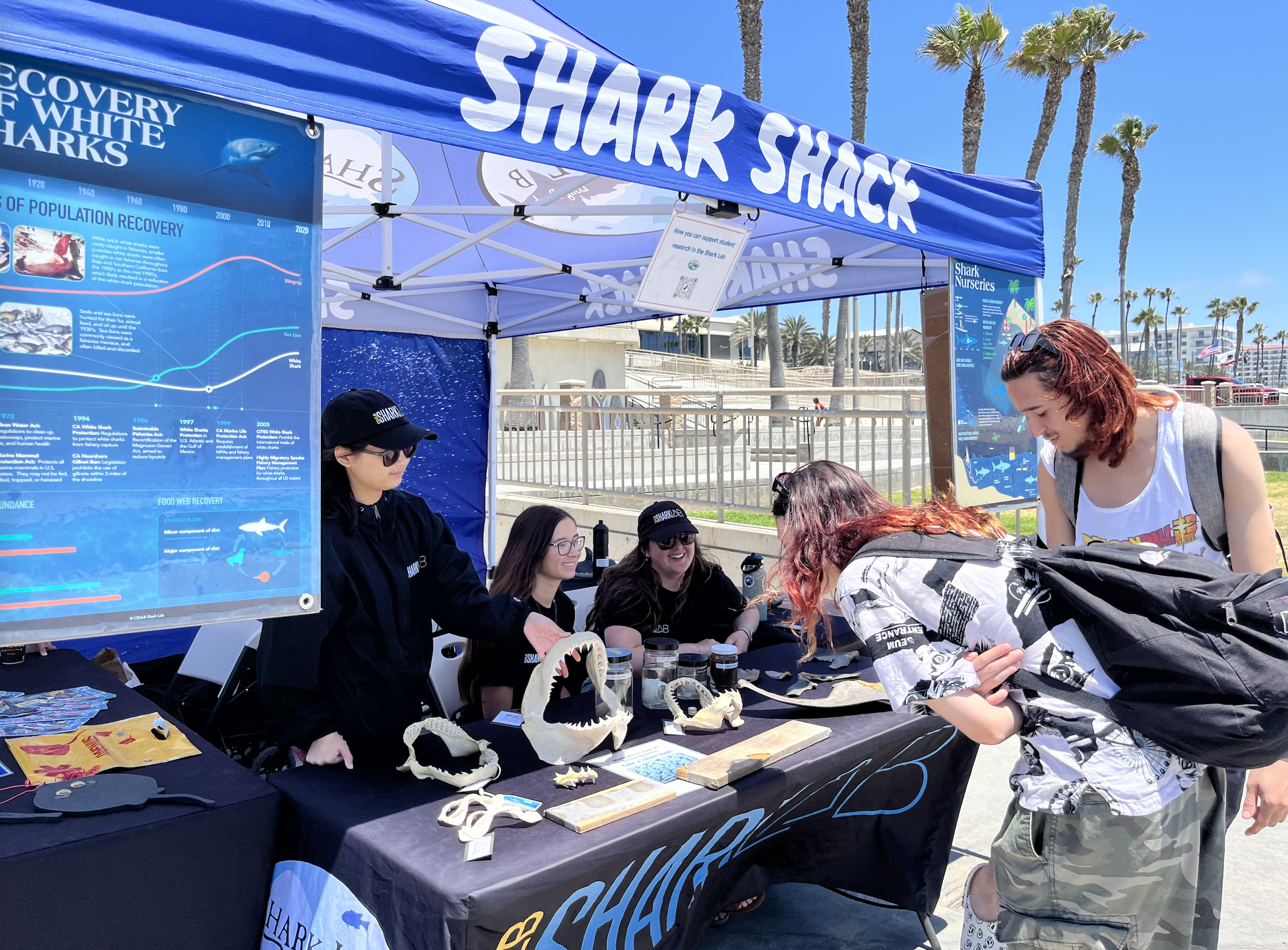
Shark Lab Tours
The Shark Lab embraced the opportunity to welcome a diverse array of groups into the lab for tours. Throughout the year, the Shark Lab has the pleasure of hosting numerous groups at the lab, including those from various on-campus departments, students from 1st grade to college, summer camp participants, and external organizations hailing from the broader Southern California region.
To book a tour yourself, email sharklabtours@csulb.edu.
Beach Safety Comic Books
The comic series was designed to deliver science-based educational content on beach safety and marine pollution to young readers in an engaging and enjoyable manner.
Check out our Comic Book Series.

Sharks @ The Beach Annual Open House Event
After a two-year hiatus, the Shark Lab and the College of Natural Science and Mathematics partnered to host the annual open-house event for the Long Beach community, called Sharks @ the Beach. We were able to open the doors to the Hall of Science once again to showcase the variety of research conducted by students and faculty, as well as various exhibits and activities facilitated by college staff. Visitors were able to see several lab spaces and learn about technology for shark research and beach safety.
Learn more about Sharks @ the Beach 2024.
Public Safety Infographics
The need for appropriate signage for informing the public of water safety hazards, has posed a challenge to most municipal water safety districts. We used information obtained through our Shark Perception study to design new info-graphics as signage for beaches to inform the public about sharks and other ocean hazards without trying to frighten or discourage their use of a beach.
